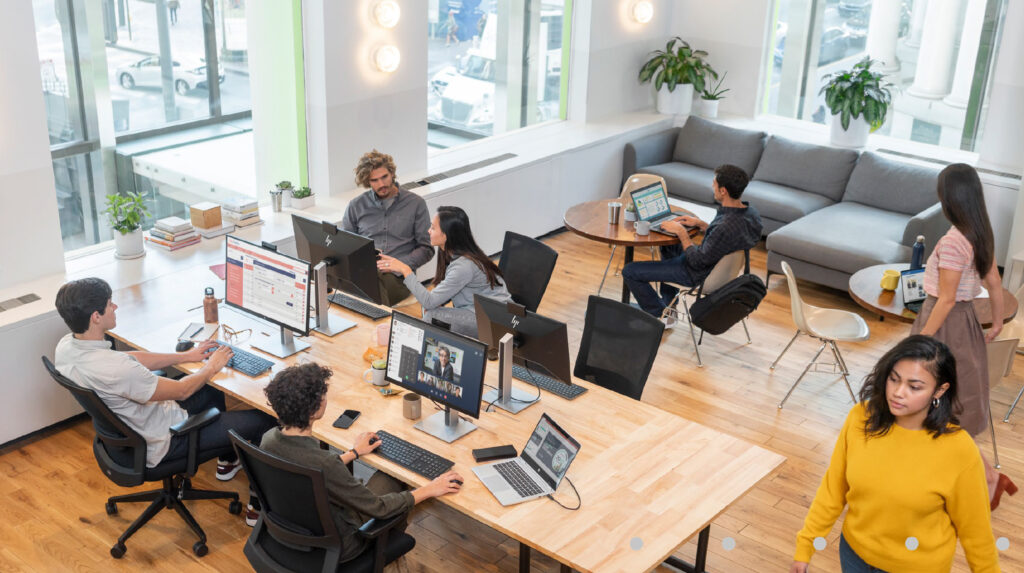
Apogee ernennt neuen CEO, der die kundenorientierte Wachstumsstrategie im Bereich Managed Workplace Services vorantreibt
5 February 2024
Wie Unternehmen die Anforderungen an die Zusammenarbeit von Mitarbeitern der Generation X bis Z erfüllen
12 February 2024
Wie wichtig es ist, dass sich “Zurück ins Büro” lohnt
Der Zwang zur Rückkehr ins Büro ist keine Entschuldigung für einen Rückfall in die Zeit vor der Pandemie - vor allem nicht, wenn Sie wertvolle Talente anziehen und binden wollen.
Gerade jetzt, wo sich die Arbeitnehmer an die Flexibilität der hybriden Arbeit gewöhnt haben, sieht es so aus, als ob die Dielen unter ihnen eine weitere große Veränderung erfahren werden. Große Unternehmen der Finanzdienstleistungsbranche - namentlich JP Morgan, BlackRock und Goldman Sachs - kehren zur obligatorischen Anwesenheit ihrer Mitarbeiter an mindestens vier Tagen pro Woche zurück.
Auch wenn dies nicht unbedingt das Ende der Ära der Telearbeit bedeutet, so zeigt es doch den Wunsch nach der kollaborativen Energie, die von Mitarbeitern ausgeht, die sich einen gemeinsamen Raum teilen - und ihr potenzieller Erfolg könnte andere Unternehmen ermutigen, diesem Beispiel zu folgen.
Die Rückkehr zu veralteten Praktiken aus der Zeit vor der Pandemie wird jedoch mit Sicherheit auf Widerstand stoßen. Jüngste Daten aus dem Financial Services Skills Commission hat gezeigt, dass 50 % der Arbeitnehmer weiterhin flexibel arbeiten möchten. Hinzu kommt, dass die Kohlenstoffemissionen, die durch den Arbeitsweg und die Energieversorgung der Gebäude entstehen, die ESG-Ziele wahrscheinlich beeinträchtigen werden.

Wenn Unternehmen also die Rückkehr zu einer 4/5-Arbeitswoche vor Ort planen, müssen sie ernsthaft darüber nachdenken, wenn sie wichtige Talente nicht verprellen wollen. Aber wie können sie sicherstellen, dass ihre Büros intelligent und nachhaltig sind und, was wohl das Wichtigste ist, dass sich das Pendeln lohnt?
Intelligente Büroräume einrichten
Wenn man bedenkt, wie sehr sich der Arbeitsplatz seit 2020 verändert hat, sollte es selbstverständlich sein, dass die Mitarbeiter nicht in veraltete Arbeitsumgebungen zurückkehren, wenn die Unternehmen eine Massenrückkehr planen - insbesondere diejenigen, die im Finanzdienstleistungssektor tätig sind, wo Innovation entscheidend ist. Nahtlose Digital- und Druckplattformen, sichere Cloud-Technologien und optimierte Dokumenten-Workflows tragen alle zur Effizienz der Mitarbeiter bei und bieten "intelligente" Umgebungen, in denen sich Top-Talente gerne engagieren werden.
Um dies zu erreichen, bedarf es natürlich mehr als nur einer neuen Ästhetik und ein paar "Breakout"-Räume. Ein wirklich "intelligentes" Büro zeichnet sich durch ein Design aus, das alle Arten von Arbeitsstilen willkommen heißt und es den Mitarbeitern ermöglicht, problemlos zwischen gemeinsamen Sitzungen, konzentrierter Arbeit und virtuellen Meetings zu wechseln - ganz so, wie sie es von zu Hause gewohnt sind, nahtlos, einfach und bequem digital zu arbeiten.

Aber dieser Gedanke ist keine ferne Wunschvorstellung. M Jedes agile Unternehmen profitiert bereits von den Vorteilen einer verbesserten Konnektivität der Mitarbeiter - durch den Einsatz von Technologie, die typischerweise frustrierende Prozesse wie die Buchung von Besprechungsräumen rationalisiert, zusätzlich zu ausgeklügelte Audio- und Videokonferenzsysteme. Jüngste Untersuchungen von Zippia haben ergeben, dass eine verbesserte Fähigkeit zur Kommunikation und Zusammenarbeit die Fluktuationsrate von Mitarbeitern tatsächlich um bis zu 50%; sowie eine Steigerung der Produktivität und des Engagements.
Menschen an die erste Stelle setzen
In unserer zunehmend digitalisierten Welt sollte es nicht überraschen, dass sich die Qualität der Technologie und die Qualität der psychischen Gesundheit inzwischen ziemlich überschneiden. Unsere jüngste Studie hat ergeben, dass sich fast ein Drittel der befragten Mitarbeiter "isoliert" und "frustriert" fühlt, wenn unzureichende Technologien für die Zusammenarbeit ihre Fähigkeit beeinträchtigen, ihre Aufgaben zu erfüllen - eine Kluft, die durch den Aufbau einer stärkeren technologischen Infrastruktur überbrückt werden kann.
Für einen reibungslosen Übergang zurück ins Büro ist es wichtig, dass Sie diesen Prozess von Anfang an richtig angehen. Deshalb ist es wichtig, dass Sie Ihren Mitarbeitern die Gründe für diesen Schritt transparent erläutern. Eine höhere Qualität der persönlichen Interaktion, die Entwicklung von Fähigkeiten und die Zusammenarbeit unter Gleichgesinnten sind alles starke Vorteile, die Sie anführen können, um Bedenken zu zerstreuen.

Die Nachhaltigkeit im Mittelpunkt behalten
Wenn Finanzunternehmen eine Rückkehr ins Büro einleiten wollen, haben sie die Verantwortung, anderen Branchen die Machbarkeit - und Notwendigkeit - der Einführung nachhaltiger und verantwortungsvoller Praktiken zu demonstrieren. Wenn sie es richtig anstellen, könnte dieser Wandel in der Branche eine wertvolle Chance für eine deutlich größere Verbreitung von ESG darstellen.
Das kann für die Zukunft nur von Vorteil sein, zumal ESG schon heute die Geschäftslandschaft von morgen prägt. Die Bauindustriezum Beispiel muss jetzt strenge ESG-Vorschriften befolgen, wenn es um den Verkauf und den Einkauf geht; und auch die Beschaffungsprozesse für den öffentlichen Sektor konzentrieren sich zunehmend darauf, dass die Anbieter in der Lage sind, einen "sozialen Wert" nachzuweisen. Außerdem wirken sich ESG auch auf die Einstellungsmöglichkeiten aus - denn 70% der Arbeitnehmer bevorzugen jetzt Arbeitgeber, die ein sichtbares Engagement für Nachhaltigkeit zeigen. Es ist klar, dass eine Rückkehr zu papierlastigen Büroumgebungen keine Option ist.

Aber Unternehmen brauchen nicht zu warten, um sich für Nachhaltigkeit zu engagieren - die Werkzeuge, die sie brauchen, sind alle jetzt verfügbar. Durch den Einsatz energieeffizienter Technologien, Qualitativ hochwertige wiederaufbereitete Geräte, die die Kreislaufwirtschaft unterstützen, und digitale Plattformen, die Papierabdrücke in Bäume verwandelnkönnen Unternehmen damit beginnen, ihre ESG-Ziele bereits im eigenen Land zu erreichen - und damit Kunden und Mitarbeiter gleichermaßen zu begeistern.
Die nächste Etappe gestalten
Die potenziellen Möglichkeiten, die sich durch die Rückkehr ins Büro ergeben, sind keine Ausrede für die Rückkehr zu alten Gewohnheiten, sondern haben erstaunliche Auswirkungen auf die Zukunft der Arbeit. Mit den richtigen Instrumenten sind Unternehmen auf dem besten Weg, ein Gleichgewicht zwischen Flexibilität, Nachhaltigkeit und Innovation an ihren Arbeitsplätzen zu finden. So können sie sicherstellen, dass das Büro nicht nur den Weg wert ist, sondern auch ein Ort, zu dem die Mitarbeiter gerne täglich fahren.
Weitere aktuelle Einblicke in die Wirtschaft und Neuigkeiten finden Sie auf unserer Seite Einblicke.
Wie wir helfen können
Um mehr zu erfahren, füllen Sie bitte das Kontaktformular aus:















































 Chief Information Officer
Chief Information Officer Chief People Officer
Chief People Officer Leiter der Finanzabteilung
Leiter der Finanzabteilung VP für laufendes Geschäft und Dienstleistungsumsatz
VP für laufendes Geschäft und Dienstleistungsumsatz